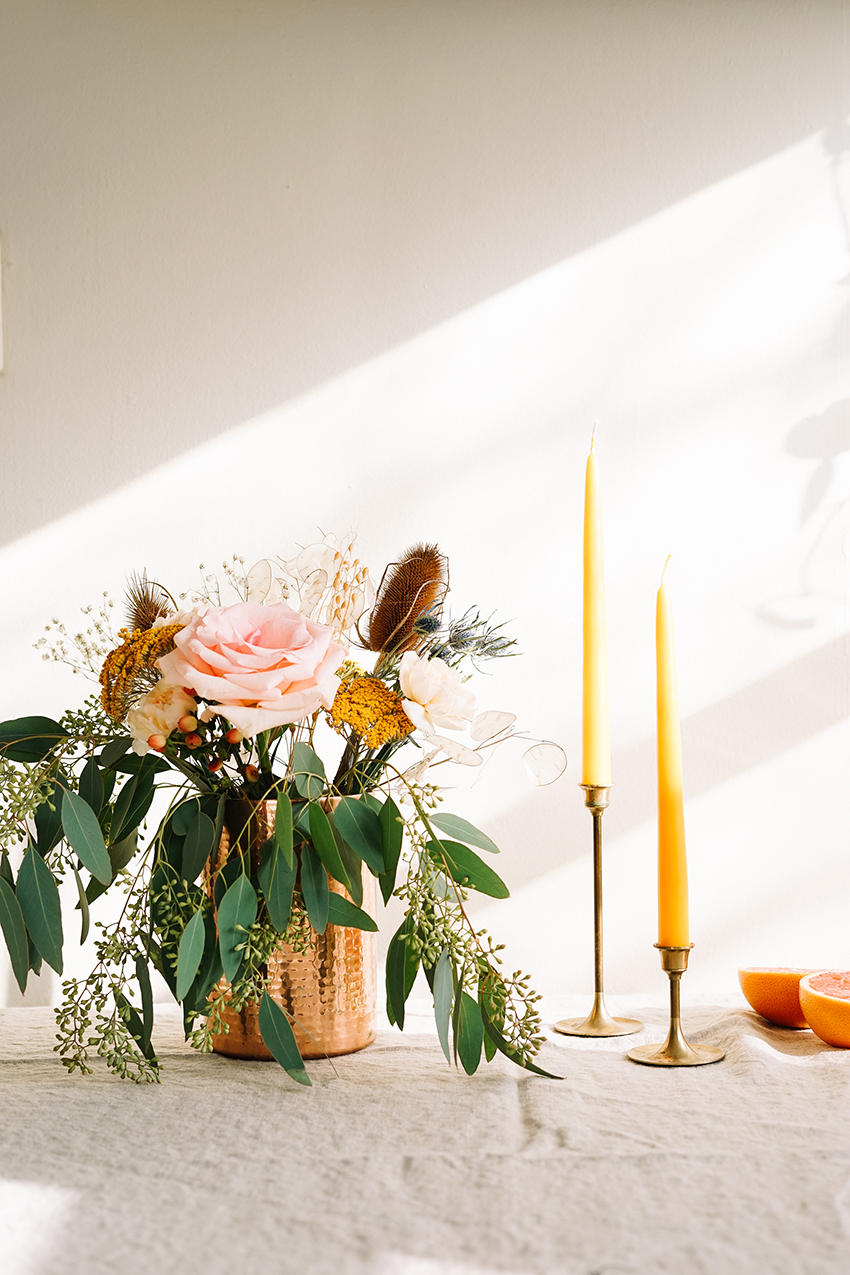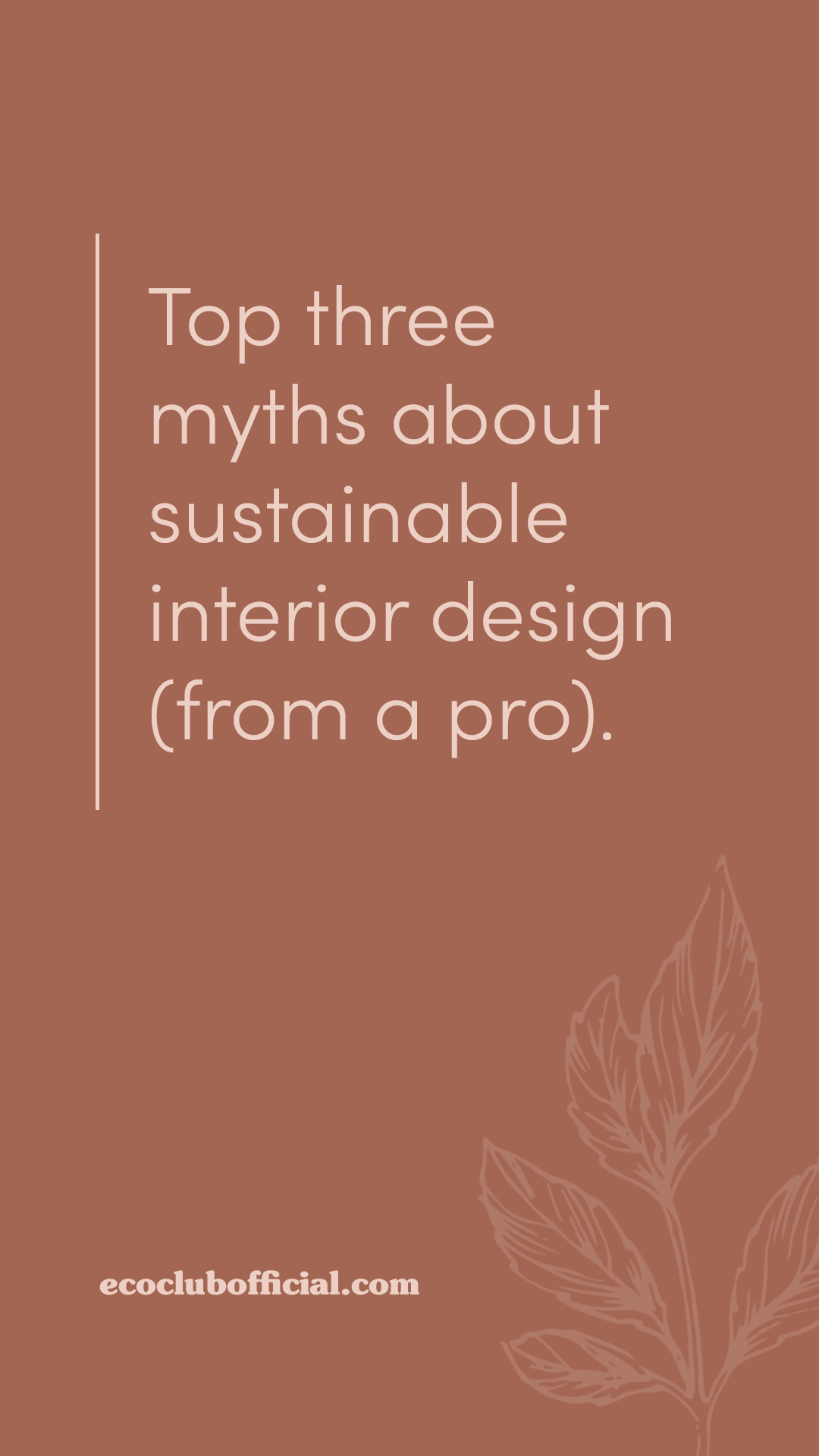For us, green living isn’t just about how to reduce your home’s footprint. It’s about finding ways to live in alignment with our environment in the warmest, most comforting and inspiring ways. Today we’ve got eco-friendly designer Holly of Holly Durocher Design chatting about all things sustainable interior design. Whether you’re a homeowner, renter, renovator, DIYer, or simply interested in the ways we can all add a little more “green” to our living spaces, I think you’ll find these three myths + the rest of Holly’s tips incredibly helpful… And a whole lot easier to consider than you might think!

three myths about sustainable interior design
Myth 1: Eco-friendly design sacrifices style
A common concern my clients have is that eco-friendly interior design won’t match their style. In the past, there were limited options, but these days basically any style you can dream up has a sustainable option. If you find a piece you love, the key is to ask questions before you buy. I recommend my clients get in the habit of asking things like: what materials is it made out of? Where is it made? How is it manufactured? For example, if the dining table you want to buy is constructed of responsibly-sourced solid wood, finished with non-toxic stains, and made in America you are on your way to a great sustainable purchase, my friend!
Myth 2: Sustainable design is too expensive
It’s super sustainable to buy vintage! It’s a great way to stay on budget, add one-of-a-kind character to your home, plus the more stuff we keep out of landfills, the better it is for the environment. If you are ready to invest in high quality furniture, it can be pricey upfront (whether it’s sustainably made or not), but in the long run you will save money by having something that will last for years that you won’t need to replace after only a couple years of use.
Myth 3: Green design is only about the environment
Sustainable interior design is about the environment, but it is also about creating a healthier home and improving your well-being. I ask my clients what their priorities are when it comes to sustainable design. Are you concerned about choosing items that are earth friendly? Do you want to create safer indoor air quality for your family? Both? This helps guide the design process in a way that is most meaningful for them. There are furnishings available that meet both of these concerns, but sometimes for budgetary or other considerations clients choose items that are primarily going to positively impact their wellness at home.

What are some real-life ways your clients have incorporated sustainable practices into their interiors?
Simple ways my clients have become more sustainably-minded include: improving their indoor air quality with the addition of house plants, natural cleaning products, organic bedding, pillows, towels and air purifiers, as well as, buying non-toxic furniture.
What’s the biggest thing a homeowner can do when designing or re-designing their space to be more environmentally friendly?
In general, I recommend choosing things that are made in America with non-toxic materials and finishes to improve your indoor air quality while reducing your carbon footprint. Purchasing a non-toxic mattress is a great place to start. Most people feel good about making an investment in a healthy mattress since it will last for years and can be moved to any new home. We spend one third (!) of our lives smooshed into our mattresses so it makes sense we’d want to sleep on something non-toxic.
Plus, the manufacturing processes for conventional mattresses tends to be far more environmentally harmful than natural mattresses. I’m happy to see that there are several great brands on the market today, but my personal favorite are Savvy Rest natural latex mattresses. I’ve had mine for about 8 years and sleep like a baby. Plus, they are an awesome Certified B-Corporation based in Virginia with great customer service.
Any favorite projects that shed a light on how attainable an eco-friendly home can be?
I truly believe eco-friendly design is easily attainable for anyone. There are more sustainable products being developed everyday giving us practically endless options. One of my clients lived in this beautiful old home and we renovated her guest bathroom. We kept her lovely vintage tub, selected gorgeous recycled Fireclay Tile, non-toxic paints, and a Paperstone countertop which is made out of recycled paper. We were able to choose all sustainable materials without sacrificing her style.
Where do you look for inspiration for your work?
I find inspiration everywhere! I feel like I’m a little design sponge constantly soaking in the world around me and filing away information for later use. Getting out in nature and seeing art are my top two. My clients inspire me as well. I love getting to know people on a personal level and then work with them to create a space that is true to them. One of my goals is to build my client’s design confidence so that they feel empowered to add to their space over time. We don’t live in museums and I think everyone should have the confidence to create a home that speaks to them.
Any tips for renters that want to maintain an eco-friendly home but can’t make major changes?
I have a list of “Intentions” that I use in my approach to every project that are great for renters and homeowners alike. Here are a few ideas:
- Choose natural cleaning products and soy-based candles that are scented with essential oils to improve your indoor air quality. Avoid chemicals and synthetics.
- Install removable wallpaper. Look for brands that use non-toxic adhesives.
- Refresh your space with no-VOC paint.
- Buy used furniture (hello Craigslist!). Get upholstered furniture professionally cleaned to remove allergens. Find a local workroom to refinish wood items or reupholster sofas and chairs to give them a new look that suits your style.
- Cozy up with certified organic bedding and towels.
Thanks to Holly of Holly Durocher Design for busting these sustainable interior design myths! See her design work and blog at hollydurocher.com.
your two cents